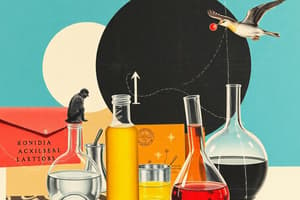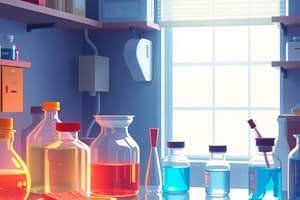Podcast
Questions and Answers
What lab equipment would you use to accurately measure and deliver exactly 50 mL of water?
What lab equipment would you use to accurately measure and deliver exactly 50 mL of water?
Pipet
If you need to pour liquids into a narrow opening, which equipment would you use?
If you need to pour liquids into a narrow opening, which equipment would you use?
Funnel
Which equipment is essential for protecting your eyes when working with chemicals?
Which equipment is essential for protecting your eyes when working with chemicals?
Goggles
What is the primary use of an Erlenmeyer flask in a laboratory setting?
What is the primary use of an Erlenmeyer flask in a laboratory setting?
Which equipment is best suited for supporting beakers when using a Bunsen burner?
Which equipment is best suited for supporting beakers when using a Bunsen burner?
What lab equipment is utilized for grinding a solid substance into a fine powder?
What lab equipment is utilized for grinding a solid substance into a fine powder?
Which equipment would you use to securely position glassware while it is being heated?
Which equipment would you use to securely position glassware while it is being heated?
Identify the tool that is used for igniting a Bunsen burner flame.
Identify the tool that is used for igniting a Bunsen burner flame.
What equipment is necessary for holding multiple test tubes upright at once?
What equipment is necessary for holding multiple test tubes upright at once?
Which equipment serves the purpose of sealing test tubes and flasks?
Which equipment serves the purpose of sealing test tubes and flasks?
What is the primary function of a graduated cylinder?
What is the primary function of a graduated cylinder?
Which equipment is best for dispensing small amounts of liquids?
Which equipment is best for dispensing small amounts of liquids?
Flashcards are hidden until you start studying
Study Notes
Lab Equipment Overview
- Glass rod: Essential for stirring chemical solutions, ensuring thorough mixing without contamination.
- Forceps: Useful for securely holding or moving small objects in a lab environment.
- Erlenmeyer flask: Versatile container used for heating, mixing, and storing solutions; its conical shape allows for easier swirling.
- Beaker tongs: Safety tool designed for handling and moving hot beakers, preventing burns.
- Funnel: Aids in filtering liquid mixtures by gravity and facilitates pouring into narrow openings without spills.
- Thermometer: Instrument used to accurately measure temperatures of substances.
- Wire gauze: Essential for distributing heat evenly from a flame, protecting glassware during heating.
- Clay triangle: Supports beakers or crucibles when placed above a Bunsen burner, providing stability during heating.
- Watch glass: Functions as a lid for beakers or as a surface for evaporating small amounts of liquid.
- Crucible and cover: Designed for high-temperature heating of substances, allowing for solid-state reactions.
- Goggles: Mandatory protective eyewear to shield eyes from chemical splashes; should be worn continuously in the lab.
- Evaporating dish: Used for evaporating small quantities of liquids, suitable for concentrating solutions.
- Wash bottle: Provides a convenient way to dispense precise amounts of liquids, facilitating clean-up and preparation.
- Well plate: Allows for conducting multiple small-scale reactions simultaneously in a controlled manner.
- Florence flask: Preferred for heating and holding liquids due to its rounded body, promoting uniform heat distribution.
- Pipet: Tool for delivering accurate volumes of liquid solutions, crucial for precise measurements in experiments.
- Buret: Graduated glass tube with a spigot at one end, allowing controlled dispensing of liquids in variable amounts, typically used in titrations.
Common Lab Equipment Overview
- Bunsen Burner: A crucial heating tool that utilizes a flame for warming chemicals in beakers or test tubes.
- Retort Stand: A sturdy frame designed to support glassware during heating, allowing for attachment of various accessories.
- Graduated Cylinder: Essential for accurately measuring liquid volumes, marked in milliliters (mL) for precision.
- Ring Clamp: Used to securely hold beakers above a Bunsen burner, typically attached to a retort stand for optimal stability.
- Rubber Stopper: Provides effective sealing for test tubes and flasks, preventing spillage and contamination.
- Test Tube Rack: Enables the upright storage of multiple test tubes simultaneously, facilitating easy access and organization.
- Beaker: A versatile container for mixing solids and liquids, often used for holding various chemical substances.
- Mortar & Pestle: A traditional apparatus ideal for grinding solid substances into fine powders for experimental use.
- Clamp: Essential for securely fastening glassware, such as test tubes, to retort stands, enhancing safety and stability.
- Sparker: A simple device employed for igniting the flame of a Bunsen burner, crucial for starting heat applications.
- Test Tube Holder: Designed for safe handling and transportation of hot test tubes, minimizing the risk of burns.
- Test Tube: A fundamental tool for mixing or holding small quantities of liquids, commonly used in a variety of experiments.
- Test Tube Brush: A specialized cleaning tool used to maintain hygiene by effectively cleaning test tubes.
- Eye Dropper: A handy instrument for dispensing precise small amounts of liquid solutions in experiments.
- Scoopula: A laboratory instrument used for scooping solid chemicals, ensuring accurate transfer during experiments.
Studying That Suits You
Use AI to generate personalized quizzes and flashcards to suit your learning preferences.




